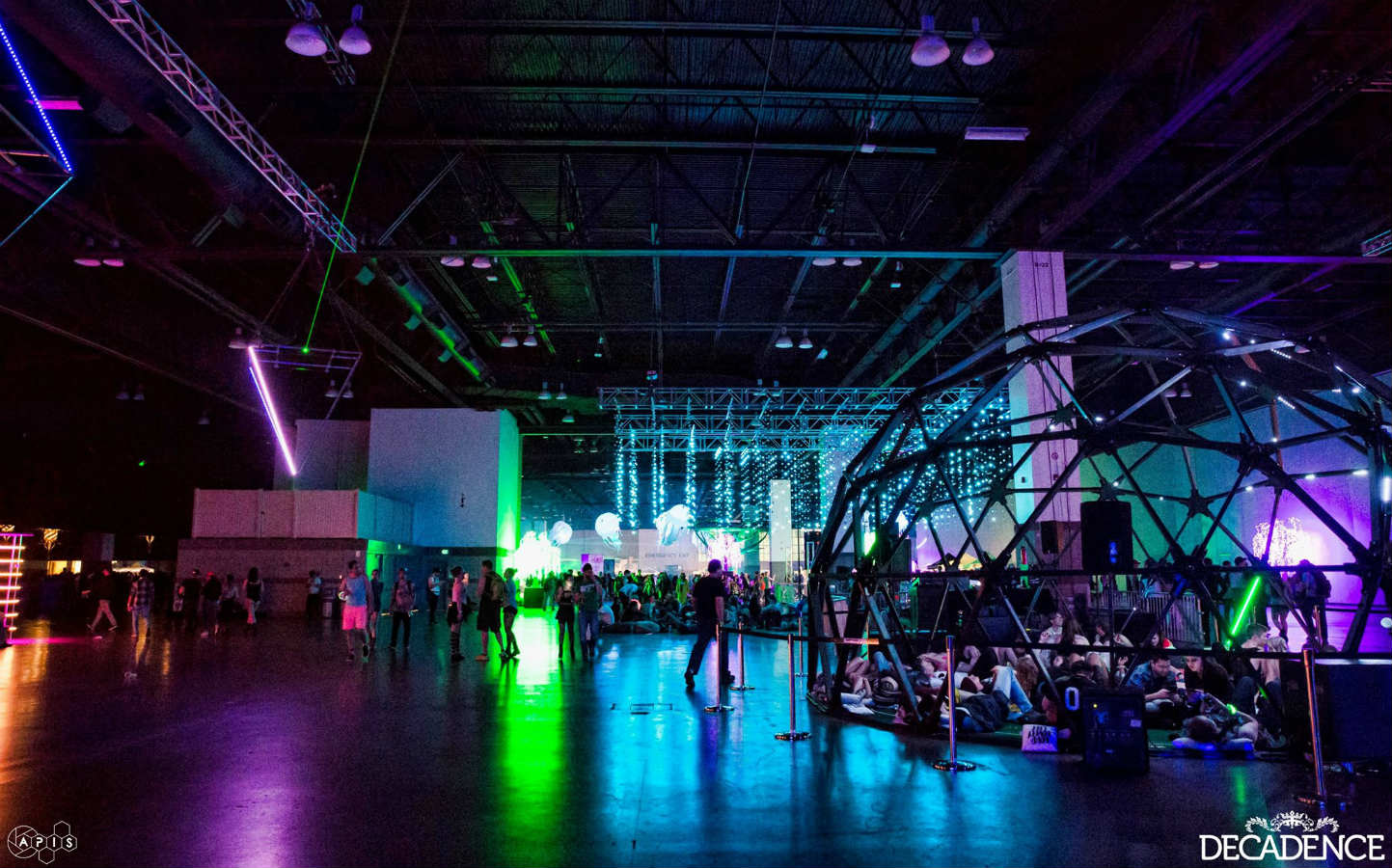Roughly 30,000 electronic music fans from the Denver Metro Area and beyond closed out 2016 at Decadence between December 30th and 31st. Knowingly or otherwise, they celebrated more than the new year alone. This past edition will have marked the turning point at which the event came into its own as a world-class festival.
That’s not to say that previous editions of Denver-based promoter Global Dance’s annual New Years Eve gathering ever fell short providing a significant draw. Since Decadence’s 2011 inauguration, each event’s lineup has featured DJs and producers as notable as deadmau5, Armin van Buuren, Kaskade and Colorado’s own Pretty Lights. In addition to bringing back such favorites as Bassnectar and Disclosure on the first day, the 2016 installment of the mini-massive added such superstars as Tiësto and Flume to the list on the second – not to mention Swedish progressive house icon Eric Prydz, whose own performance unsurprisingly stood out as the sonic crescendo of the entire occasion.
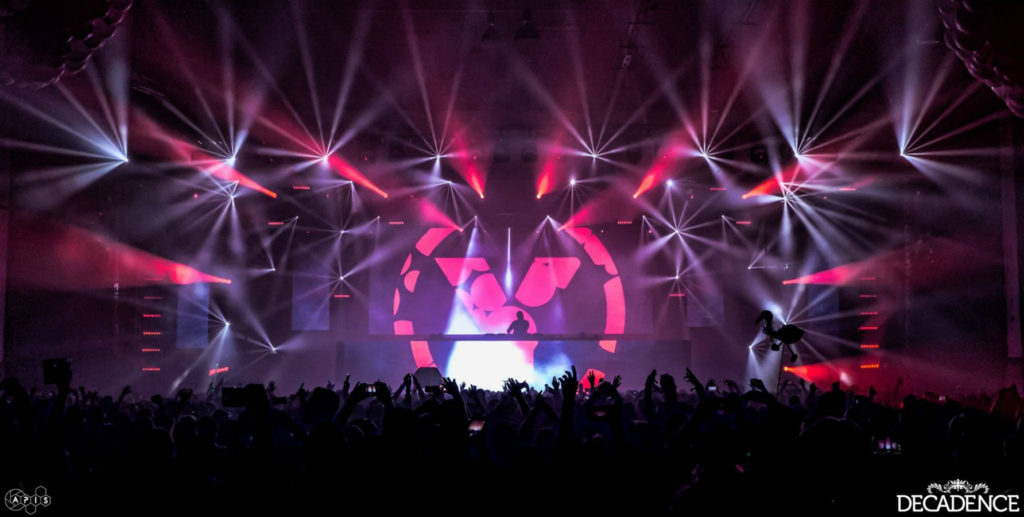
Eric Prydz at Decadence 2016. Photo Credit: Apis Photography
More importantly, however, this year’s edition exhibited a cohesion of concept that had gone missing in years prior.
It’s not easy to fill the vast, echoing expanse comprising the Exhibit Level of the Colorado Convention Center. Even after walling off sections of the space to prevent sound clashing, walking from stage to stage has typically made attendees feel like they’ve crossed into areas of the production where they don’t belong.
Where the light-up installations of previous years stood as solitary islands in a vast sea of otherwise disconnected staging elements, this year the exhibit hall connecting the two main rooms – billed the Daydream Stage and the Timekeeper Stage this year – was adorned with much larger LED-covered sculptures. Massive octahedrons twinkled from above as revelers passed underneath, giving way to a 3D grid of pulsing orbs on strings framed by radiant columns on either side. Even the honeycombed paneling of the Silent Disco stage on the opposite end of the hall made it feel more like an actual stage and less like a halfhearted concession made to deserving local up-and-comers like Aaron Bordas, Freddy Rule and Yagobi vs. GynSyn.
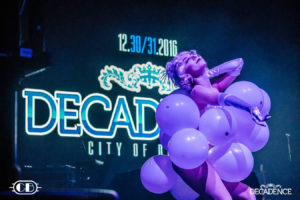
A Team EZ gogo dancer at Decadence 2016. Photo Credit: Chief B
This time around, Denver-based dance crew Team EZ also took cues from what promoters like Insomniac Events have been doing with choreographed entertainers at West Coast massives. Aside from dolled-up gogo dancers, who themselves engaged with the audience more than ever before, surreal performers on stilts routinely made their rounds throughout the space. Combined with every other facet of the production, this added human element that transformed the 2016 edition of Decadence into the very “city of dreams” in the festival’s tagline.
That wasn’t all, though. Perhaps most importantly, a brand new Chillout Dome stage made for both the literal and figurative centerpiece of the entire occasion.
The LED-lined geodesic dome between the aforementioned art installations and Silent Disco was new – at least to Decadence. The same piece of staging had been used as a stage in the 2016 edition of Bass Center, another Global Dance event that took place at DSG Park in Commerce City, Colorado. This time around, though, it arguably served a much more profound purpose.
For the better part of both evenings, the dome housed a contemporary take on chillout rooms – also termed “chill rooms” – an anachronism of early rave culture. Chillout rooms featured DJs who played softer styles of electronic music like ambient and downtempo in order to provide revelers a respite from otherwise operpowering live music environments. More notably, a tenured fixture of Denver’s dance music scene manned the decks: LL Bishop.
Bishop was involved with the Denver rave scene all the way back in 1990, the year he originally moved to the Centennial State. While taking a break from spinning to let his apprentice, Dagan Turner, take the helm, he confessed to djbios that he had “almost semi-retired from DJing” in recent years.
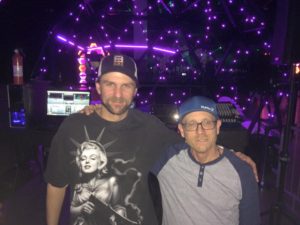
Left to right: Dagan Turner and LL Bishop at Decadence 2016.
“I was coerced to do this by my buddy, Julian [Bradley], who owns Electronic Sales and Production,” he said. “He’s an old friend of mine who used to be a part of Poor Boy Productions in the early ‘90s. He’s involved with [Decadence] and now he’s controlling all the lights and lasers in all the rooms.”
Last year an inflatable dome designed by Alan “Endorfun” Rushlow (the mind behind each edition’s balloon drop as well as numerous installations) had encapsulated the EDM.com Silent Disco stage. 2015’s dome collapsed before it could be repurposed in 2016, and Bradley, who had built the new dome, also conceived of its reimagined role in the production. Interestingly, it was not advertised on any of Decadence’s marketing materials; it simply stood as a monolithic mystery to be discovered by any festivalgoer who came across it while passing between attractions.
Bishop explained that Bradley had approached him about DJing at the Chillout Dome (or the “Cuddle Puddle Dome” as Bishop quipped on Facebook) about a month and a half prior to the event. For the most part, he and Turner filled each open-to-close set with ‘90s classics from such artists as Orbital, The Future Sound of London, and Motorbass.
The duo kept the tempo and timbre of each selection purposefully mild. “We don’t want any dancing in there,” Bishop remarked in a patient yet gravelly tone of voice. “It’s mellow, man. We want ‘em all sitting and laying in there.”
Sure enough, they did – and in droves. At any given time, the circle of turf under the dome was densely packed with bodies gazing up at a skyline of soothing bursts coursing through the beams connecting the network of contiguous triangles. At numerous points, security even had to make attendees wait in line at the entrance until others got up and left.
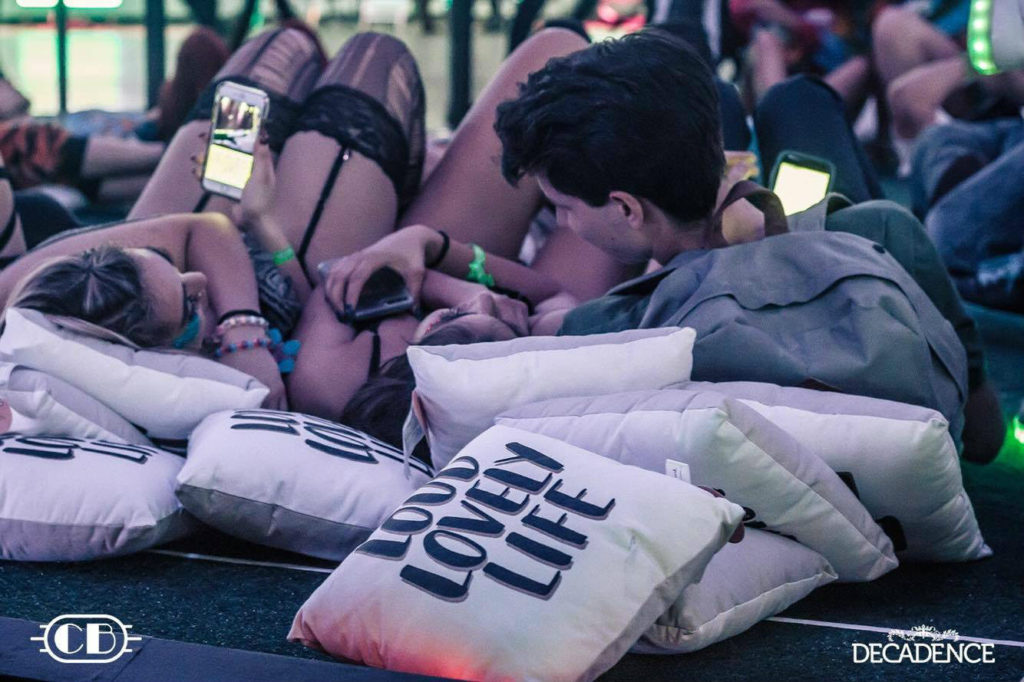
Photo credit: Chief B
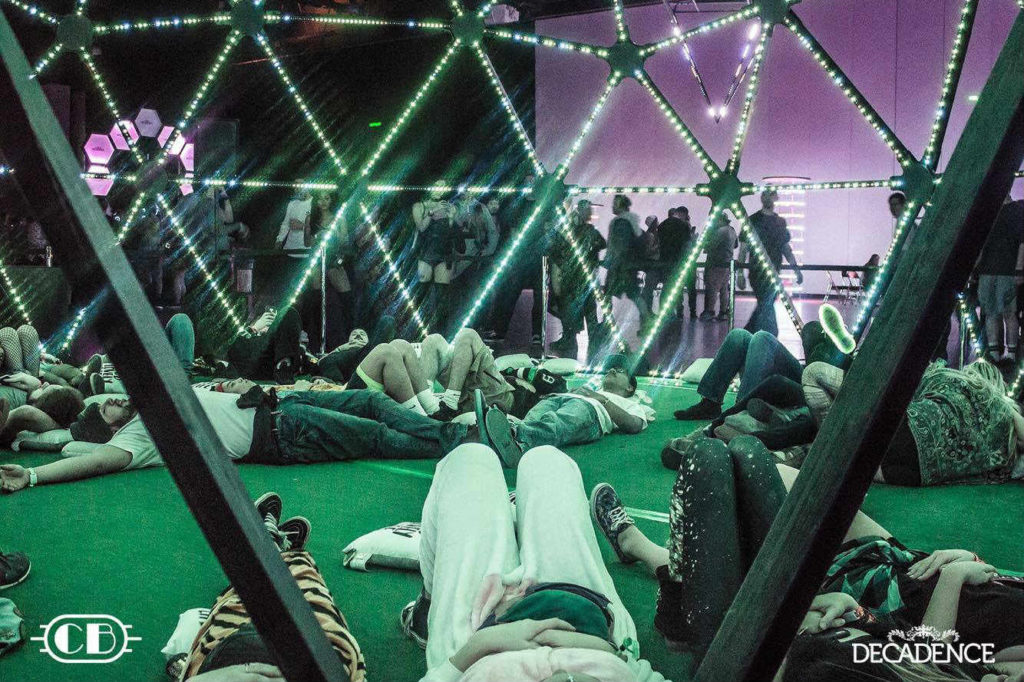
Photo credit: Chief B
According to Bishop, the dome was quite a departure from chillout rooms of yesteryear. “What’s going on in that dome, we were doing in apartments 25 years ago during the mornings after parties in Dallas with Rob Vaughan and things like that,” he recounted. “It’s really strange to see how much it’s evolved.”
Fortunately, Bishop’s involvement with Decadence even appears to have reinvigorated his passion for DJing. He revealed that he would return to play an even bigger version of the Chillout Dome in the 2017 edition of the festival, adding:
“I’m probably gonna do a little more stuff like this, the more mellow-end thing that we’re doing. Especially at my age, I always said that if I do this I’m going to do something on the mellower side. Julian pulled me into this, and I’m gonna start helping him do these chill rooms – these ambient, trippy rooms.”
Efforts to personalize Global Dance’s brand were long overdue. In recent years, many of the company’s dealings had left a sour taste in the mouths of music enthusiasts throughout the Denver scene. Especially considering Global’s controversial decision to give a dozen or two local DJs time slots on a stage that was only accessible to VIP guests at the 2016 edition of Hallowfreaknween back in October, a strategic measure to bolster Global Dance’s local reputation was timely indeed. Up to now, Global Dance’s events had came across more manufactured than ever.
That said, there’s much to suggest that the Decadence organizers’ redoubled attention to the event’s atmosphere was more a shift in Global Dance’s company culture than it was some cold, methodical business decision. Denver is something of a bass music mecca, and the distribution of talent on the roster certainly reflected that. Still, bookings like Swiss tech and psytrance DJ/producer Sean Tyas or Canadian livetronica band Bob Moses demonstrated the talent buyers’ willingness to stay ahead of broader trends (even though this time around, neither artist commanded the draw they deserved).
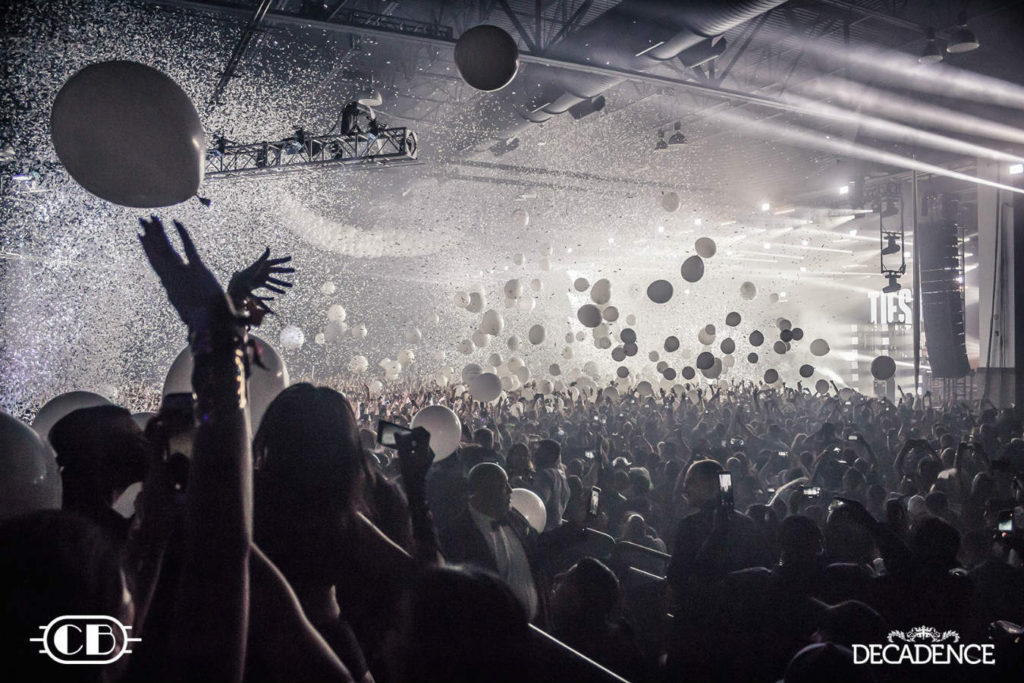
Photo credit: Chief B
The popularity of the Decadence Chillout Dome may make an even more encouraging statement on contemporary dance culture than that. It was the smallest stage, to be sure – but to see more dated and subversive styles of electronic music so warmly embraced by younger fans who themselves were lured to the gathering by entry-level acts like Showtek, Adventure Club and Marshmello suggests that, knowingly or otherwise, the new generation of fans might be more receptive to classic sounds than their elder statesmen sometimes speculate.
If this past installment of Decadence was any indicator, the new year could mark a turning point for Global Dance. As tumultuous as 2016 may have been for dance music, changes may well be on the horizon.


